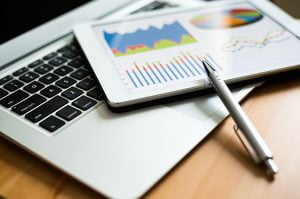 Summary: While many organizations use business/executive dashboards, not all dashboards are created equal. Some dashboards are key business tools, while others are nothing more than charts on a page. In this article, you’ll learn a few ways your business can take your dashboards to the next level–turning them into key business drivers.
Summary: While many organizations use business/executive dashboards, not all dashboards are created equal. Some dashboards are key business tools, while others are nothing more than charts on a page. In this article, you’ll learn a few ways your business can take your dashboards to the next level–turning them into key business drivers.

Do you ever get the feeling that your dashboards are nothing more than graphs on a page?
You hear about the value of good dashboards. You read stories about other organizations that use dashboards to drive business.
But, you aren’t seeing the value out of your dashboards. They aren’t driving much of anything.
It’s a common problem with dashboards. So many businesses want dashboards. But, when they get dashboards, they don’t use them to their full potential.
The big questions: How can you take your dashboards to the next level? How can you make them more than charts on a page?
Today, let’s explore that topic. Here are a few ways you can take your dashboards to the next level.
1. Throw out your vanity metrics
Too many dashboards are cluttered with vanity metrics. These are elements that look nice, but don’t lead to action.
On the flip side, you’ll find actionable metrics. These are metrics that drive decisions. These are metrics that you want on your dashboards.
The first step in taking your dashboards to the next level: Examine each of your metrics. How does each one drive action? Would a change (either up or down) lead to a decision?
“A dashboard is not about eye candy and colorful charts; it’s about making quick, informed decisions,” says Freddy Mini, CEO of Netvibes. “With all the data and analytics together on your dashboard, it’s the best place for business automation. Make sure your dashboard can react on its own to make decisions where
seconds are critical.”
The big question: How can you tell the difference between a vanity metric and an actionable metric? Here’s an example for you:
Suppose you have a customer service dashboard. A vanity metric might tell you how many customer support issues your support staff has resolved this month. It might even tell you how quickly they resolve issues on average.
Now, does that really tell you anything that can drive action? If the numbers are abnormally high, you might want to dig deeper. But, it doesn’t tell you anything on the surface.
Now, consider a dashboard that displays WHICH issues customers contact your support staff about. The dashboard could even display average time to resolve every type of issue. That’s data that drives action. You can quickly see which areas of your product or service needs attention.
2. Extend dashboards across the business
Dashboards are too often viewed as an executive tool–and little else. They’re used to give decision-makers a clear view of their business.
The problem with this approach: It limits the dashboard’s value. Dashboards are far more than a tool for business leaders. They can be used across your entire business.
“Many times I hear business leaders say that they need everyone driving the same direction,” says Jean Cook, Business Coach and Certified Facilitator at Corporate Performance Group. “One good way to help with that is to make the dashboard a tool for your team beyond the executive office/s. If the leaders and workers up and down the org chart all know the goals and where you are at in getting there everyone can point their activity in the direction you want.”
3. Make them relevant
Many businesses make a critical mistake: They deliver the same dashboard to many users. Parts of the dashboard are relevant to some, while other parts are useful to others. Some employees just ignore it altogether, because it doesn’t apply to them at all.
Here’s a key rule with dashboards: One size doesn’t fit all. For a dashboard to be useful to different users, they must see data that applies to their specific role.
“A good dashboard is a relevant dashboard,” says Levent Gurses, founder of Movel. “Too often, dashboards are designed too narrowly for a small number of people and for the rest, they are simply not relevant. If we can’t relate to the data, we can’t use it for anything productive.”
Now, I know what you’re thinking: “How can we possibly give every user a unique dashboard?”
It’s a valid question. Especially in larger companies, where you might have hundreds of users, delivering unique dashboards to each user isn’t feasible.
Here’s one way around that problem: Give users customizable dashboards. Let them adjust the data displayed on the dashboard, as well as the layout. This way, you give multiple users a single dashboard that they can adjust to fit their needs.
4. Make them accessible
You may have the best, most useful dashboard ever created. It might include actionable data that drives decision-making. It might extend across the entire business, delivering relevant data to every user.
But, if it’s not accessible whenever and wherever your users need it, is it a useful dashboard?
“A good dashboard is accessible, from anywhere, to anyone,” says Gurses. “For business meetings a web-based dashboard can easily be projected to the screen. For specific team rooms, a dashboard screen can be a permanent fixture on the wall. Whatever it is, it needs to be easily accessible at any given time.”
The fact is, employees aren’t tied to their desks anymore. Dashboards shouldn’t be tied to the desktop.
Now, this goes beyond smartphones and tablets, though mobile-accessible dashboards are important. As explained above, your dashboard must be accessible to your employees whenever they need it. For instance, I’ve seen some manufacturing companies place monitors on their shop floors just for dashboards. These dashboards track progress and goals throughout the day, and are always accessible to the employees.
5. Give them depth

Many dashboards feel like they’re nothing more than charts on a page…because that’s all they are. They offer no interactivity. They offer no data exploration. They’re simply a graphical representation of data.
The problem with this approach: It limits the dashboard’s effectiveness. It hurts the user’s ability to get a clear view of the data. An effective dashboard gives you actionable data, with the ability to get more details if needed.
“A truly useful dashboard must have the ability to drill-down,” says Gurses. “When key decisions are made, detailed data may be needed. A dashboard with the ability to drill-down will provide the necessary detail for the most critical business decisions.”
6. Measure progress towards your goals
“Dashboards must have the goal and the result,” says Cook. “Knowing that you shipped 10,000 items this week doesn’t help unless you know how many you needed to ship to hit your goals.”
It’s a key element that many dashboards lack. They track data, but ignore goals. If you truly want to take your dashboard to the next level, you must track both. A goal gives everyone in your company something to aim for, and the dashboard tracks real-time progress towards that goal.
But, it’s not just about your goals and progress. As explained below, once you’ve established your goals, you can break that down into actions needed to accomplish those goals. Once broken down, you can track progress on each action that leads to your goal.
“Measure not just financial results but productivity as well,” says Cook. “A dashboard does not take the place of your monthly financial statement review, the dashboard tells you how you are driving toward your destination. Know what your goals are and measure the things that will get you there. The items you track on your dashboard must give you an ability to predict the result. For example if you want $400,000 of sales a month, you need $100,000 a week and you need to know that the activity to get that $100,000 a week in the future is happening. So, don’t just measure the sales $, measure the activity/s that will lead to those future sales $. For example, # of in-person sales calls or #/$ of quotes completed.”
7. Give the full picture
Another big problem I frequently see with dashboards: They only tell part of the story. The dashboard only integrates with one aspect of a company’s data, but doesn’t combine data from different sources.
For instance, a dashboard might pull data from the ERP system, but ignore data in the warehouse management and online ordering system. Some businesses still have a good amount of data floating around in spreadsheets–which doesn’t get included in the dashboard.
Data quality lies at the foundation of any effective dashboard. If your data isn’t comprehensive (or clean), your dashboard cannot truly be effective.
“Like every chef will tell you: to get the best cuisine, you need the best ingredients,” says Mini. “Intelligence and cuisine are both about transformation of raw materials into perfect outcomes. So make sure you have a strong collection of data sources you trust for your various projects/monitoring needs.”
Summary
These are just a few ways to take your dashboards to the next level, but there are plenty more. If you would like to add anything to this list, I’d love to hear it. Feel free to share in the comments.